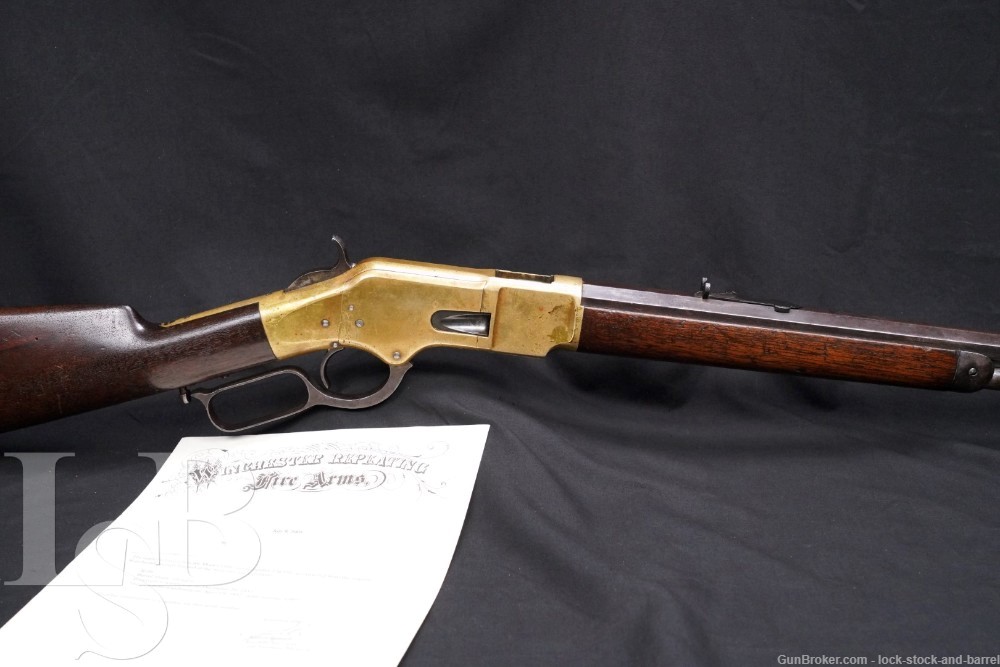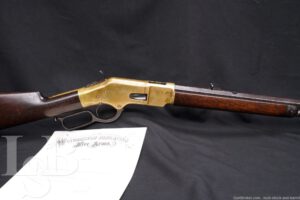
Winchester 1866 4th Model 24″ .44 Henry CF Lever Action Rifle, 1881 Antique
SOLD FOR: $5,125
LSB#: 231025BC047
Make: Winchester Repeating Arms Co.
Model: 1866 Rifle 4th Model
Serial Number: 156310
Year of Manufacture: 1881
Caliber: .44 Henry. The bolt appears to have been altered for both centerfire and rimfire, but the bolt face appears damaged.
Action Type: Lever Action with Tubular Magazine.
Markings: The top of the barrel is marked “WINCHESTER’S-REPEATING ARMS. NEW HAVEN. CT / KING’S-IMPROVEMENT-PATENTED-MARCH 29.1866. OCTOBER 16. 1860”. The lower tang is marked “156310”. The left of the bottom tang, the upper tang inlet and the inside of the buttplate at the toe are each marked with assembly number “2208”.
Barrel Length: 24” nominal, 24 1/4″ measured, Octagonal
Sights / Optics: The front sight is a german silver blade in a slotted base dovetailed to the barrel at the front. The rear sight is a “V”-notch elevator sight dovetailed to the rear of the barrel. The top tang is drilled, tapped and filled for a tang sight (none present)
Stock Configuration & Condition: The stocks are two-piece smooth walnut with an iron capped forend, straight comb, straight grip and iron crescent buttplate with a sliding door over a storage compartment (there is nothing in the compartment). There is a repaired crack in the left-front of the forend. There is a small repaired chip in the left of the wrist at the bottom-front corner. There are some nicks, dings, scuffs and scratches. The most notable marks are in the buttstock, there is one small but deep mark on the left of the forend toward the rear. The LOP measures 13 3/8″ from the front of the trigger to the back of the buttplate. The plate has gone to a moderate patina with wear at the heel and scattered surface erosion. Overall, the stocks are in about Very Good condition as Antique.
Type of Finish: Blue & Brass
Finish Originality: Original
Bore Condition: The bore is dark gray. The rifling is well defined. There is scattered light-moderate erosion and pitting in the bore. In this writer’s opinion, the bore rates 5 out of 10.
Most antique firearms have bores that will show erosion. This is not only due to age but to the use of black powder. When fired, black powder reacts corrosively. NRA Antique Firearm Conditions Standards are quite lenient for bores. In some cases, the NRA standards disregarded the bore’s condition for collectors’ firearms.
Overall Condition: This rifle retains about 25% of its metal finish. The barrel and magazine tube have infrequent finish in well protected areas. Most of the steel parts have worn to white or gone to a light patina. There is some scattered surface erosion. There are tool marks on and around the magazine bracket and the magazine cap. The receiver has gone to a mustard patina with most areas showing the crystalline appearance of old brass. As noted above, there is damage on the bolt-face. There are scattered nicks, dings, scuffs and scratches, most notable in the receiver, with tool marks around some screw heads. The action shows operational wear. The screw heads range from sharp to disfigured with usable slots. The markings range from clear to worn, but legible. Overall, this rifle rates in about Good condition as Antique (see Mechanics).
Mechanics: The bolt-face has a rimfire striker bushing, but it appears to have been altered for center-fire at one time. The bolt face shows damage. Otherwise, the action functions correctly. The hammer has a half-cock safety. We have not fired this rifle. As with all used firearms, a thorough cleaning may be necessary to meet your maintenance standards.
Box, Paperwork & Accessories: This rifle comes with a Winchester factory records letter which indicates that the rifle was received in warehouse on December 20, 1881 and shipped April 19, 1882.
Our Assessment: The Model 1866 rifle was the first firearm to be built by the new Winchester Arms after they changed their name from the New Haven Arms Company in 1866. The Model 1866 was a much-improved version of the Henry rifle, with a loading port on the right side of the receiver featuring a spring-loaded cover, through which cartridges could be fed into a new solid magazine tube that was much stronger than the slotted tube used on the Henry. The loading gate precluded the need for an external follower, allowing for a walnut forend to be installed which prevented the user from burning their hands during extensive firing. The M1866 was made in rifle, carbine and musket versions and in four different models dependent on date of manufacture. All of the different models were chambered in .44 Henry Rimfire, with some of the later 4th Models chambered in .44 Henry Centerfire and some converted to Centerfire later.
This is a Model 1866 4th Model Rifle made in 1881, after the successor Model 1873 had been introduced. The rifle has honest wear given its age, though the bolt face appears to have been modified at some point and now shows damage. This Fourth Model is distinguished by the iron nosecap and buttplate as well as the slightly different profile of the receiver at the hammer. Most Winchester collectors would never think that their collection was complete without at least all three variations of the M1866, while some would argue for all of the variations of the four different models. This 1866 4th Model Rifle will be a neat addition to a collection and would be a good candidate for restoration. Please see our photos and good luck!
Please forgive any typos, I was educated in California -Bud

